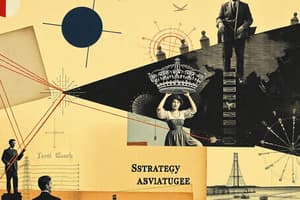Podcast
Questions and Answers
Which of the following best describes strategic management?
Which of the following best describes strategic management?
- Reacting to immediate market changes without long-term planning.
- Planning, implementing, and evaluating actions to achieve long-term goals and competitive advantage. (correct)
- A static plan that does not adapt to market changes.
- Focusing solely on internal resources while ignoring external factors.
Strategic management is less important in highly competitive industries.
Strategic management is less important in highly competitive industries.
False (B)
What are the main components of strategic management?
What are the main components of strategic management?
Planning, Implementation, Evaluation
The principle of __________ assumes that organizations can, in part, create their environment.
The principle of __________ assumes that organizations can, in part, create their environment.
Match the following strategic management perspectives with their primary focus:
Match the following strategic management perspectives with their primary focus:
According to the resource-based view, what is a key source of competitive advantage?
According to the resource-based view, what is a key source of competitive advantage?
Deliberate and emergent strategies are mutually exclusive; a company must choose one or the other.
Deliberate and emergent strategies are mutually exclusive; a company must choose one or the other.
What is the primary difference between deliberate and emergent strategies?
What is the primary difference between deliberate and emergent strategies?
A __________ analysis is used to evaluate Strengths, Weaknesses, Opportunities and Threats.
A __________ analysis is used to evaluate Strengths, Weaknesses, Opportunities and Threats.
Match the following SWOT components with their definitions:
Match the following SWOT components with their definitions:
What does strategic direction primarily define for an organization?
What does strategic direction primarily define for an organization?
Functional-level strategies define the overall domain in which a company will compete.
Functional-level strategies define the overall domain in which a company will compete.
Name the three levels of strategy that an organization makes
Name the three levels of strategy that an organization makes
__________ refers to the processes that lead to adjustments in strategic direction, strategies or the implementation plan when necessary.
__________ refers to the processes that lead to adjustments in strategic direction, strategies or the implementation plan when necessary.
Match the following characteristics with strategic thinking
Match the following characteristics with strategic thinking
What is the role of segmentation in the hospitality industry?
What is the role of segmentation in the hospitality industry?
The broad environment is firm and industry dependent.
The broad environment is firm and industry dependent.
List four key elements in the broad environment
List four key elements in the broad environment
Social responsibility is when a firm takes a ________ stance in its social role, going beyond what is called for by law.
Social responsibility is when a firm takes a ________ stance in its social role, going beyond what is called for by law.
Match the economic power in an industry
Match the economic power in an industry
Flashcards
Strategic Management
Strategic Management
Planning, implementing, and evaluating actions to achieve long-term goals and maintain a competitive advantage.
Traditional Perspective
Traditional Perspective
Adapting the organization to its environment by leveraging strengths, opportunities, and overcoming weaknesses and threats.
Resource-Based View
Resource-Based View
Acquiring superior resources, skills, and abilities that are valuable, rare, and difficult to imitate for sustained competitive advantage.
Stakeholder View
Stakeholder View
Signup and view all the flashcards
Deliberate Strategy
Deliberate Strategy
Signup and view all the flashcards
Emergent Strategy
Emergent Strategy
Signup and view all the flashcards
Principle of Enactment
Principle of Enactment
Signup and view all the flashcards
Strengths
Strengths
Signup and view all the flashcards
Weaknesses
Weaknesses
Signup and view all the flashcards
Opportunities
Opportunities
Signup and view all the flashcards
Strategic Direction
Strategic Direction
Signup and view all the flashcards
Strategic Management (Definition)
Strategic Management (Definition)
Signup and view all the flashcards
Strategy Implementation
Strategy Implementation
Signup and view all the flashcards
Strategic Intent
Strategic Intent
Signup and view all the flashcards
Segmentation
Segmentation
Signup and view all the flashcards
Operating environment
Operating environment
Signup and view all the flashcards
Joint Venture
Joint Venture
Signup and view all the flashcards
Customer Bargaining Power
Customer Bargaining Power
Signup and view all the flashcards
Supplier Power
Supplier Power
Signup and view all the flashcards
Exit Barriers
Exit Barriers
Signup and view all the flashcards
Study Notes
Strategy and Strategic Management
- Strategic management involves planning, implementing, and evaluating actions to achieve long-term goals and competitive advantage.
- It includes analyzing internal and external environments, setting objectives, developing strategies, and allocating resources.
- The hospitality business is fiercely competitive, exemplified by McDonald's expansion and rivalry in the fast-food market.
- Successful companies effectively acquire, develop, and manage resources and capabilities for competitive advantages, unlike those that are subject to luck and ultimately fail.
- Companies that practice strategic planning perform better than those that don't, with 81% of companies worldwide reporting strategic planning practices.
- Strategic planning positively impacts hospitality firms
Origin of Strategic Management
- Increasing competition drives the need for strategic management.
- Transportation and communication improvements facilitate global trade and awareness.
- Technological advancements accelerate changes in the global economy.
- There has been increasing interest and multiple new perspectives on strategic management in the past two decades.
Three Perspectives on Strategic Management
- Traditional perspective: Firms adapt to the external environment to gain a competitive edge.
- Resource-based view: Firms leverage unique resources, skills, and abilities for competitive advantage.
- Stakeholder view: Firms build superior relationships with stakeholders, leading to trust and better performance.
The Traditional Perspective
- Relies on economic principles and business disciplines.
- Analyzes external and internal environments to formulate strategies.
- Aims to adapt the organization to its environment by leveraging strengths and opportunities.
Resource-Based View
- Emphasizes economics, distinctive competencies, and general management capability.
- Focuses on analyzing organizational resources, skills, and abilities, for competitive advantage through superior resources.
- Focuses on rare and hard to imitate resources.
Stakeholder View
- Considers business ethics and social responsibility.
- Analyzes the power, influence, rights, and demands of stakeholders.
- Aims for superior stakeholder linkages, trust, and goodwill, ultimately improving firm performance.
Enactment vs. Adaptation
- The principle of enactment suggests organizations can create their environments via strategic alliances, investments, advertising, and lobbying.
- Smaller organizations have limited ability to singly influence their environments.
- Key to enactment lies in firms not fully adapting to environmental forces, but influencing aspects to their desired goals.
Deliberate vs. Emergent Strategy
- Deliberate strategy: Strategy is planned and intended.
- Emergent strategy: Strategy emerges from decisions and learning over time.
- Organizations should adapt to environmental forces when enactment costs outweigh benefits.
- They should proactively create opportunities and pursue deliberate strategic planning.
- It is key to also be open to learning and emergent strategies based on the circumstances.
The Resource-Based View
- It grew from the question "Why do some firms persistently outperform other firms?"
- Effective leadership is important.
Key Resources for Competitive Advantage
- Financial resources: Monetary resources a firm can use
- Physical resources: Land, buildings, equipment, locations, and raw materials access
- Human resources: Skills, background, and training of managers and employees
- Organizational knowledge and learning
- General organizational resources: External relationships with stakeholders, firm reputation, brand names, patents and contracts
The Organization
- It is becoming a network of stakeholders through alliances and contracting.
- Includes suppliers, activist groups, competitors, local communities, owners/board of directors, the media, and financial intermediaries.
Strategic Management Process
- Strategic management involves the analysis of perspectives: the traditional model, the resource-based view, and the stakeholder approach.
- Consisting of: a situation analysis, setting strategic direction, formulating specific strategies, and strategy implementation.
Key Strategic Activities
- Situation analysis: Analyzing internal and external environments, including resources and stakeholders
- Strategic direction: Establishing mission, vision, and organizational goals and creating mission statements.
- Strategy formulation: Creating specific strategies
- Strategy implementation: Designing organizational structure, control processes, and managing stakeholder relationships and resources.
SWOT Analysis
- Strengths: Company resources and capabilities leading to a competitive advantage
- Weaknesses: Resources and capabilities that a company lacks and impede competitiveness
- Opportunities: Conditions in the environment that allow a firm to leverage strengths or overcome weaknesses
- Threats: Conditions in the environment that may hinder a firm's competitiveness
Strategic Direction
- Strategic direction guides longer-term goals and objectives.
- Defines the fundamental purposes of the company's existence.
- Is articulated through mission and vision statements.
- It is important to understand it provides guidance to stakeholders and external parties.
Strategy Formulation and Its Three Levels
- Corporate level defines the company's domain of activity (business areas
- Business level pertains to domain direction and how selected businesses should compete.
- Functional level focuses on how department resources are used to implement strategy and attain a competitive advantage.
- Corporate-level decisions often come from the C-Suite, while decisions for business-level are made by division heads, and managerial staff form and execute functional level strategies.
Strategy Implementation
- Strategy implementation represents an action of decisions and patterns to carry out a plan. It moves the business toward the successful execution of strategies.
- Organizational control involves adjustments to strategic direction or strategies when necessary.
- Strategic control systems should ensure strategies are appropriate and well-executed by the business.
Strategic Thinking
- It includes the following
- Intent-focused vision of where the firm is going
- Comprehensive systems perspective
- Opportunistic mindset
- Long-term orientation
- Understanding of the past and present
- Hypothesis-driven, risk-taking approach
Strategic Management in Hospitality
- The hospitality industry includes businesses providing accommodation, food and beverage, or both.
- Hospitality offerings are services (immediately consumed and people-intensive).
- It is segmented on criteria like price, function, style, offerings and service.
- Classifications include: luxury, upscale, midscale with food and beverage services, mid-scale without food and beverage services, and economy.
Environmental Analysis
- Successful organizations anticipate concerns, predict trends, and generate ideas through environmental analysis.
- It identifies external threats and opportunities.
The External Environment
- It consists of the broad and operating environments
- Broad environment - impacts many industries and firms, consists of: sociocultural, global economic, political and technological influences
- Operating environment is specific to each business
Socio-Cultural Context
- Societal trends have been influenced by factors like sociocultural, as an evolving set of shared beliefs, values, and attitudes to help shape how a social group thinks.
- It gives rise to population demographics and trends, or research that can be used in marketing to understand subgroups.
- Culture is made up of the individuals who make up a geographic region.
- Culture is important for shaping how people think, see act, and react to situations.
Corporate Reputation
- It can be enhance through positive relationships with stakeholders (customers and suppliers).
- Can avoid problems due to being a “bad corporate citizen.”
Social Responsibility
- Through assessing social trends, businesses avoid restrictive legislation, or any threat to organizational success.
- Social responsibility is when a firm proactively and favorably operates beyond the required laws and regulations.
- This not only promotes ethical actions, but allows firms to improve society.
Economic Forces
- Organizations must understand and be aware of economic forces, and constantly assess and monitor, as it is linked to demand and profit potential of its services and goods.
Monitoring Economic Forces
- By examining: Economic growth, consumer demand, cost of production.
- By observing: costs for new projects, cost of refinancing debt, and consumer demand. These are also the general effects of interest rates.
- Examining; interest rates and attitudes through metrics like inflation.
- Studying: the ability to profitably remove profits from foreign ventures through variables like exchange rates.
- Trade deficits can affect the business' policies and incentives.
Political Influences
- Governments provide and enforce laws, regulations, and policies
- Can incentivize new businesses through subsidies, or restructure if they fail to comply.
Technological Impact
- Creating entire new industries through producing new products, and services in a way that the society accepts.
- Technological change is difficult to predict, the three traits in characterizing innovation
- Can be helped by using data and current research data to better predict and forecast when trends and shifts come.
Managing Technological Change
- By surfing the Web, studying journals, and staying current through gathering the latest reports.
- By soliciting or getting experts outside of the organization.
- Conducting “what-if" analysis and developing alter
- native plans by understanding alternate technological routes.
Environmental Relationships
- Example of environmental forces: social situations intertwined with economic forces include the countries with lowered birth rates. Improved health and longer lifestyles influencing labor shortages
Environmental Factors
- Tourism infrastructure
- Cross-border openness
- Availability of tourism support
- Frequency of airline routes.
Importance of Stakeholders
- Not all stakeholders are equally important to the business.
- Stakeholders are various and able to influence an organizations direction to different degrees.
- Exploring the relationships that exist between an organization and external stakeholders, it helps discuss the power particular stakeholder groups have to influence firm behaviour and success.
5 Economic Forces
- Power of new entrants
- Suppliers
- Competitors
- Substitutes
- Customers
Economic Powers of Customers
- Customers provide for products and services.
- Because that may be withheld, they have the bargaining power and the economic power.
- Customers who have influence can affect operations, the extent to which that happens varies.
Gaining Bargaining Influence
- From earning low profits.
- Airlines concessions from airports are useful.
Economic Power of Suppliers
- Power to raise prices, lowering buying industries profitability.
- Raise industry's uncertainty of environment.
- Provide for costs to switch.
Industry Influencers
- Being few in number
- Providing one-of-a-kind service
- Being a separate customer
- Integration with other companies
Factors Leading to Higher Competition
- Competition may result from high-profit industry
- Slow industry growth
- Few levels of diversity or standardization
Competitive Tactics
- Consists of high fixed costs
- May have barriers to exist or enter business
- Several forces must compete (suppliers, buyers) entry barriers exist
Barriers to Entry
- Economies of scale
- Capital requirements can prevent an entry.
- Product differentiation
- established customer base
Formal Stakeholder Powers
- Stakeholders have a legal or contractual right
- Can also be regulators.
Studying That Suits You
Use AI to generate personalized quizzes and flashcards to suit your learning preferences.




